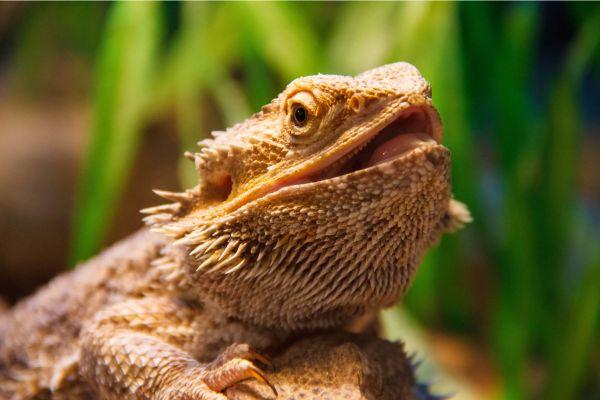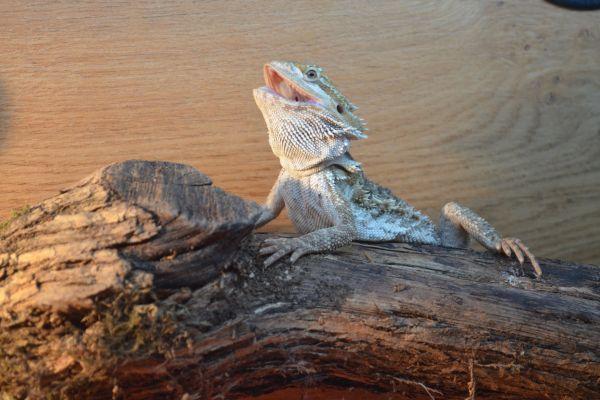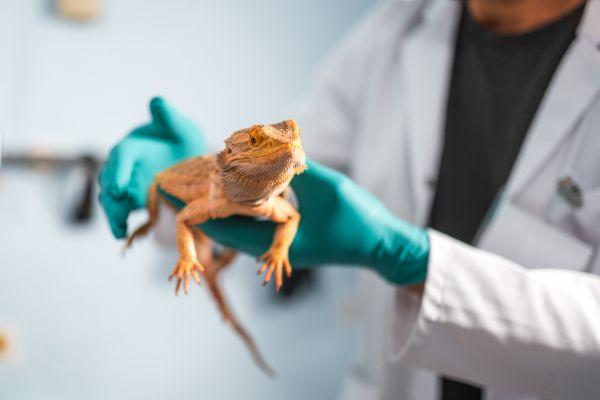Bearded Dragon Care 101: A Guide for New Owners
Posted by Spencer Doepel on
Are you new to owning a bearded dragon? Congratulations on your newest scaly friend!
Beardies are the perfect companion if you are looking for something a little different, but they come with a unique set of needs.
But have no fear, because this blog is here to get you started! In this blog, you will find the basics of bearded dragon care.
So sit back, take a deep breath, and let us give you the ins and outs of keeping a healthy and happy beardie. Let's get started!
Quick Recap of Key Points
Bearded dragon care involves providing the proper diet, habitat, and tank temperatures. It is also important to monitor their health and provide regular vet visits.
Table of Contents
Bearded Dragon Care Basics
Enclosure Setup & Housing
Heating & Humidity Management
Lighting & Sunlight Requirements
Nutrition Requirements & Supplements
Handling and Veterinary Care
Answers to Frequently Asked Questions
Bearded Dragon Care Basics
First, let's start with the Bearded Dragon Care basics. These are the essentials for your bearded dragon to thrive and remain healthy.
Basic care requires owners to understand bearded dragon's needs in terms of food, housing, and their environment.
Feeding bearded dragons should vary depending on the bearded dragon's age but consist of a mixture of insects and vegetables.
In addition to food, proper housing is a necessity when it comes to bearded dragon care.
There has been debate on what type of enclosure works best for them; while some prefer glass tanks, others suggest PVC Enclosures.
Ambient air temperatures should range from 75°F - 85°F with a basking spot of 95°F - 105°F.
Bearded dragons also need ultraviolet light exposure to help synthesize nutrition from their food, so UVA/UVB bulbs will be necessary in either enclosure setup.
Understanding proper care gives new owners the confidence they need to properly tend to the needs of their bearded dragons and ensure their health, vitality, and happiness for years to come.
Now that you've got all these basics down, let's talk about what types of food your bearded dragon can eat and how much.
Nutrition Requirements & Supplements
Bearded dragons can grow very quickly from babies at a few inches to two feet.
Baby and Juvenile bearded dragons should be fed a diet consisting of 60% live feeder insects and 40% plant matter. An adult bearded should be fed a diet of 25% live feeder insects and 75% plant matter.
Some of the feeder insects you can feed your reptilian friend are
- Black Soldier Fly Larvae
- Crickets
- Mealworms
- Waxworms
There are many different types of plants your bearded dragon can eat. Here is a list of just a few.
- Dark leafy greens
- Collard greens
- Mustard greens
- Kale
- Squash
- Occasional fresh fruits
It is also important to dust all feeder insects except black soldier fly larvae with calcium powder. This helps the bearded dragon's bones developed and keeps them strong in their old age
Also adding in a mineral and vitamin supplement about once every two weeks can also help boost their growth rates significantly.
It is important not to overfeed your adult dragons as obesity can cause problems such as kidney issues and gout.
It is also essential to pay attention to what your dragon’s type of diet consists of; some dragons may be pickier or require more than the standard. In this case, adjust the amounts to what works best for them.
Providing fresh water is critical for the proper care of bearded dragons. Make sure there is always fresh water in your pet lizard cage. Having the water the depth of the bearded dragon can also help with enrichment and shedding.
Overall, providing the correct nutrition for your Bearded Dragon is essential for their health, development, and well-being.
Enclosure Setup & Housing
Now that you have an idea of the food you can feed your bearded dragon, let's dive a little deeper into what you can do to help your bearded dragon thrive in their new home.
Enclosure setup and housing should be tailored to the individual's specific needs. When deciding on how to house a bearded dragon, there are two main types of enclosures: Glass Aquariums and PVC enclosures.
There are pros and cons to both enclosures.
The glass aquarium habitats have a screen top that lets in airflow and light. This type of enclosure allows more of a visual connection with the pet but may be more difficult to maintain at a consistent temperature than a PVC enclosure.
This type of enclosure can be bought at your local PetSmart or Petco.
Meanwhile, PVC Enclosures are made with high-quality PVC that is better suited for temperature regulation by providing more insulation from the outside environment; however, they make it harder to monitor the pet and can be more expensive.
Here is a list of some customer PVC enclosure builders.
The size of the enclosure should be triple the size of the pet - for adult dragons 60 gallons or a comparable size is recommended.
It is best to provide enough space for a beardie to live comfortably since inadequate housing can lead to stress and health problems.
Additionally, many prefer items like rocks, branches, or fake/live plants to give their pet something interesting to explore and climb on.
Lastly, it is critical that owners take proper precautions when setting up their reptile’s habitat; all cage accessories should be thoroughly cleaned and disinfected before use, and cages should be kept away from any drafts or direct sunlight.
Also, make sure everything in the enclosure is secure and nothing can fall on the bearded dragon.
With all these factors taken into consideration, owners can create a safe and enriching home for their scaly friends which will help them thrive and grow!
Heating & Humidity Management
Once the terrarium is set up, it is important to carefully manage the heating and humidity for your bearded dragon.
The environment should be kept between 85-105°F with a temperature gradient. During the night, temperatures can drop as low as 70-75°F.
There are two different ways to heat your bearded dragon's cage. With a heat lamp from overhead or from a heatmat under the cage. Both are sufficient heating methods when used correctly.
For a Heat Lamp use no more than a 100 Wat heat lamp. If you decide to use a heatmat make sure it is connected to a digital thermostat to emit the correct heating temperature.
It is also important to control humidity levels in order to maintain your bearded dragon’s health. Keeping the relative humidity between 30 and 40 percent will ensure that your reptile won’t experience any breathing problems or skin issues due to dryness or excessive moisture.
To keep humidity levels at a constant, place a shallow water dish inside the terrarium, which will increase the surrounding humidity. When misting the enclosure with a spray bottle it's best practice not only during shedding time but also several times throughout the week as part of regular maintenance.
Proper heating and humidity management is essential for creating an optimal environment for your bearded dragon. With careful monitoring these temperatures and creating correct conditions within their terrarium, you can create a comfortable and safe space for your beardie!
Now that you know what temperature and humidity levels should be monitored we will move onto thermostat control of temperature and humidity.
Lighting & Sunlight Requirements
Now that your bearded dragon pet has been appropriately set up for ideal temperature and humidity control, it is important to provide the proper lighting and sunlight requirements.
A natural spectrum fluorescent bulb should be used for their basking bulbs, while a separate UVB bulb should be provided for vitamin D production. Special reptile fixtures are available from pet supply stores that contain both lights in one unit.
It is recommended that lights be attached outside the terrarium, in order to keep the interior free of excessive heat buildup or burns.
When utilizing these light bulbs, careful attention should still be paid to making sure they do not overheat or burn the dragon if it gets too close to the bulb or fixture.
As previously mentioned, frequent visits outdoors during warm weather months (assuming temperatures are safe) are recommended in order to absorb natural UVB radiation from sunshine to optimally support their growth and life cycle.
Having explored temperature and humidity, lighting and sunlight requirements for a happy and healthy bearded dragon habitat Let discuss another vital piece of caring for a Bearded Dragon: handling and veterinary care.
Handling and Veterinary Care
After discussing the Lighting requirements for your beardy it's time to talk about handling and vet care. It's important for bearded dragon owners to consider handling and veterinary care as a top priority.
Handling your Bearded Dragon is critical to bonding with them; however, due to health concerns, such as the risk of infection or causing stress, experts recommend that owners avoid doing so too often.
Instead, opt for minimal interaction that involves gentle and quick moments. This includes brushing or lightly rubbing against their skin and limbs when offering food or checking for injuries will help keep them calm. Also, give them plenty of time to explore its environment on its own.
As for veterinary care, veterinarians who specialize in reptiles are recommended for proper treatment of a Bearded Dragon. Whether it's diagnosing illness or scheduling a routine checkup, a reptile veterinarian can both diagnose and treat your lizard in the best possible way.
They can also offer advice on proper habitat construction and nutrition requirements as well as provide suggestions if you need a second opinion on any potential illnesses.
Although generally small animal vets may be more convenient to some owners, they often lack experience with reptiles and therefore may not be able to provide accurate diagnoses or treatments.
Similarly, do-it-yourself solutions found online aren't always reliable, so it's highly recommended that consistent follow-ups with an experienced herp vet are scheduled annually in order to ensure your lizard's health is monitored regularly.
It’s also important to remember that even with the same species of reptile like the Bearded Dragon that no two individuals are alike when it comes to disease susceptibility or dietary needs – what works well for one individual might not work well for another.
As such, paying close attention to the signs exhibited by your particular pet is essential in curating an effective care regime that keeps him healthy and happy in its day-to-day life – hence why veterinary consults are so important!
Answers to Frequently Asked Questions
What should the temperature and humidity levels be for a bearded dragon?
When it comes to creating a comfortable and healthy environment for your bearded dragon, temperature and humidity levels are two key factors you must monitor regularly. An ideal temperature range would be between 80-95 degrees Fahrenheit during the day and between 70-75 degrees Fahrenheit at night.
The temperature of the basking spot should remain between 95-105 degrees Fahrenheit. As for humidity, the levels should remain around 30%-40% - too much or too little can be detrimental to their health.
Of course, you must also take note of proper ventilation and UVB exposure as they can both have an effect on the overall quality of your bearded dragon’s environment.
How often do bearded dragons need to be handled?
Bearded dragons typically need to be handled a few times per week to become comfortable with their environment and bond with their owners. A good rule of thumb is to handle your bearded dragon for 5-10 minutes at least two days out of the week. It's important to go slowly and let your bearded dragon adjust to being handled before touching them for longer periods of time.
Additionally, handling should be done in a calm environment with minimal distractions. Be sure to always provide support under the body when handling your bearded dragon, as they can easily become stressed if left unsupported. Following these guidelines will help create a trusting relationship, while also allowing them to grow comfortable in their new home.
What type of housing is best for a bearded dragon?
The best type of housing for a bearded dragon is an enclosure that replicate the natural desert habitat in which the species would be found in the wild. This should include UV lighting and heat sources, as well as substrate or reptile carpet. The enclosure should also be well-ventilated and at least 2 to 3 times longer than your bearded dragon is long.
It should also have enough climbing surfaces, branches, grasses, and rocks. Additionally, provide a large water dish big enough for your beardie to soak in and lots of hiding spots, such as caves or hides.
Finally, make sure to keep their enclosure clean and monitor the temperature and humidity levels regularly.
How do I bathe my bearded dragon?
Bathing your bearded dragon is an important part of their care and can help keep them healthy. To bathe your dragon, first make sure you have a shallow container with enough warm water that your dragon can comfortably stand in up to its shoulders. You'll also want to make sure the water is not too hot or too cold- a temperature around 80°F should be ideal.
Once the water is ready, gently place your dragon into it for about 10 minutes. During this time, you can use a clean, soft toothbrush to help remove any dirt or debris from their skin.
After the bath, carefully lift your dragon out and wrap them in a dry towel to help them dry off and stay warm.
Additionally, you may wish to provide some misting spray as an extra soothing measure for particularly dry days.
What do bearded dragons eat?
Bearded dragons are omnivores, meaning they eat both plants and animals. In their natural habitats, they eat a variety of insects, such as black soldier fly larvae, crickets, mealworms, waxworms, super worms, and roaches.
Depending on the size of your bearded dragon, you may also want to offer them pinky mice every once in a while for a bigger meal. In addition to these proteins, you should also provide fresh vegetables and occasional fruit for your bearded dragon’s healthy diet.
A good staple would be dark leafy greens like collard greens, turnip greens and mustard greens. Other vegetables that are okay to feed your bearded dragon are bell peppers, squash, carrots, peas, beans and sweet potatoes.
Lastly, it is important to provide calcium supplements to balance the phosphorus level in their diet. Dust prey items with calcium supplement every feeding.




